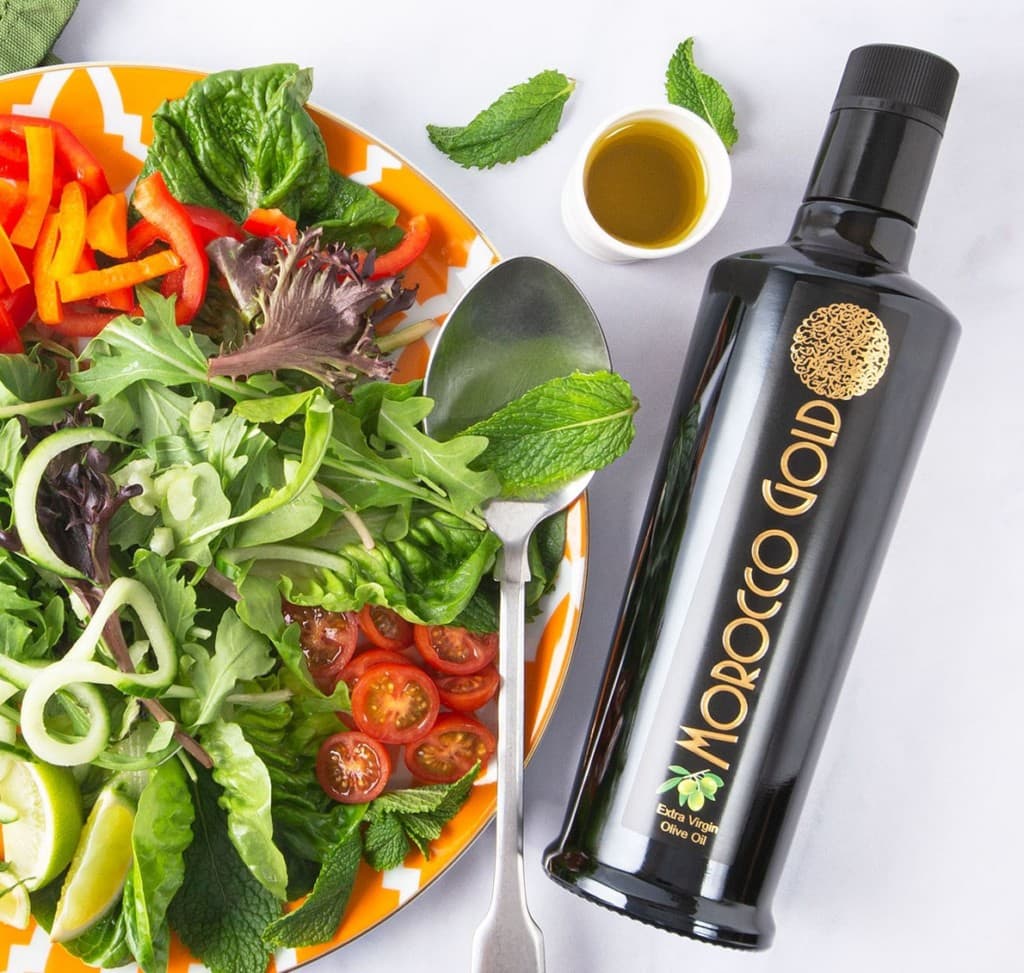Comparing The Mediterranean And Nordic Diets
Updated February 26th 2025

Summary
- The Nordic Diet is a healthy eating plan that includes extra virgin olive oil as a key fat source.
- Both the Nordic Diet and The Mediterranean Diet are a great source of Omega-3 Fatty Acids found in fish oil and quality olive oil.
- Extra Virgin Olive Oil has a higher polyphenol content than Canola Oil – the other oil used in the Nordic Diet.
- The polyphenol count of Morocco Gold is dependent on attention to detail at every stage in the production process.
Contents
- The Nordic Diet Versus The Mediterranean Diet: Where Does Olive Oil Fit Best?
- What Do The Mediterranean Diet and The Nordic Diet Have in Common?
- The Benefits Of Healthy Fats Like Extra Virgin Olive Oil
- Can You Eat Olive Oil On The Nordic Diet?
- Extra Virgin Olive Oil Has The High Polyphenol Factor!
- The Takeaway: The Best Olive Oil Has A Place In The Nordic Diet Too!
The Nordic diet has been gaining popularity for its health benefits and focus on locally-sourced, sustainable ingredients. But if you’re someone who also loves incorporating olive oil into your meals, you might wonder—does olive oil have a place in this Nordic-inspired way of eating? Let’s explore where olive oil fits within the Nordic diet and uncover some key insights about healthy fats.
The Nordic Diet Versus The Mediterranean Diet: Where Does Olive Oil Fit Best?
Are you a health-conscious food lover looking for ways to incorporate extra virgin olive oil into your diet? Look no further! In this blog post, we explore how this beloved oil can be used in both the Nordic Diet and the Mediterranean Diet, two popular eating styles known for their numerous health benefits.
Both the Nordic diet and Mediterranean diet are often praised for their health-promoting properties. While the Mediterranean diet is known for its abundant use of olive oil as a primary fat source, the Nordic diet traditionally emphasises ingredients like canola (rapeseed) oil, fatty fish, and locally-inspired produce such as berries, whole grains, and root vegetables.
This difference in staple oils stems from their geographic and cultural origins. Olive oil has been a hallmark of Mediterranean cuisine due to its availability in the region, while canola oil is more accessible in Nordic countries.
However, the lines may not be as rigid as they seem. The growing awareness of olive oil’s health benefits makes it a universally appreciated ingredient that can potentially complement the Nordic diet.
Whether you’re a fan of the fresh flavors of Nordic cuisine or the rich, bold tastes of Mediterranean dishes, extra virgin olive oil is a versatile ingredient that can elevate any meal. Join us as we delve into the world of olive oil and discover the delicious ways you can incorporate it into your diet for a healthier lifestyle.
The vastly popular Mediterranean Diet is facing some stiff competition from a Scandinavian competitor. But what is the Nordic Diet and can you include Olive Oil in your eating plan? The Mediterranean Diet, rich in olive oil, has long been a favourite eating plan for those looking to improve their health and reduce the risk of conditions such as heart disease, high cholesterol, osteoporosis, and some cancers. But the more recent emergence of The Nordic Diet – focussing on foods which are grown locally and organically – is putting up some fierce competition.
What Do The Mediterranean Diet and The Nordic Diet Have in Common?

Despite their geographical differences, the Nordic and Mediterranean diets have much in common when it comes to nutritional principles:
- Focus on whole, minimally-processed ingredients: Both diets encourage eating whole foods, including fruits, vegetables, whole grains, and healthy fats.
- High intake of plant-based foods: Legumes, nuts, seeds, and leafy greens are core components.
- Heart-friendly fats: While the Mediterranean diet is synonymous with olive oil, the Nordic diet highlights fatty fish rich in omega-3s and canola oil as sources of heart-healthy fats.
Both diets also promote sustainability, mindfulness, and ethical food choices, making them adaptable to the lifestyles of modern, health-conscious individuals.
The Benefits Of Healthy Fats Like Extra Virgin Olive Oil
Healthy fats are a vital component of any balanced diet, and extra virgin olive oil (EVOO) is one of the most celebrated sources of good fats. Here are some of the standout benefits of EVOO:
- Rich in monounsaturated fats: These fats can reduce bad cholesterol levels, lowering the risk of heart disease.
- Packed with polyphenols: These are powerful antioxidants that combat inflammation and oxidative stress, supporting overall health.
- Supports brain health: Research suggests that the consumption of olive oil is linked to improved cognitive function and a reduced risk of neurodegenerative diseases.
- Enhances flavour: It’s not just about health; the depth of flavour that EVOO brings to dishes is unmatched.
As explained by Yahoo Lifestyle, the Nordic diet may offer similar benefits to plant-based eating styles such as vegan and vegetarian diets. Eating more plants (and less meat) is associated with a lower risk of chronic conditions, including heart disease, stroke, type 2 diabetes, and cancer, according to the American Heart Association.
The Nordic diet may also help followers to manage high cholesterol, one of the primary risk factors for heart disease.
This is due to the high volume of Omega-3s – also present in quality olive oil – which can help lower your levels of cholesterol and triglycerides — which can increase your risk of heart disease.
Also similarly to The Mediterranean Diet, The Nordic Diet might also reduce the risk of low-grade inflammation or chronic inflammation. Inflammation can be a key factor in the development of chronic diseases, such as type 2 diabetes and heart disease.
Can You Eat Olive Oil On The Nordic Diet?
While most guidance around The Nordic Diet suggests that, unlike the The Mediterranean Diet which relies on Olive Oil, the primary fat source is Canola (Rapeseed) Oil. Both Olive Oil and Canola Oil are plant-based and contain high quantities of omega-3 fatty acids. However, it is reported that canola oil has more omega-6 fatty acids than omega-3 fatty acids.
As reported in a 2018 article, while Omega-6s are also beneficial for the heart, the ratio of omega-6s to omega-3s is crucial factor. A high omega-6 to omega-3 ratio can increase inflammation, while a high omega-3 to omega-6 ratio reduces it.
For Nordic diet enthusiasts, olive oil can work well alongside other staples. For example:
- Drizzle olive oil over root vegetables like carrots, parsnips, or turnips before roasting.
- Use it as a dressing for your salads made with Nordic greens, such as kale or cabbage.
- Pair it with whole-grain rye bread or barley dishes for an extra flavour boost.
The adaptability of the Nordic diet makes it user-friendly for those who already love olive oil or who wish to benefit from its high nutritional value.
Don’t Forget: Olive Oil Has The High Polyphenol Factor!
If you are still undecided on your fat of choice, we have one key factor that we think gives a premium quality extra virgin olive oil the edge over all others. It is the exceptional high quantities of very powerful antioxidants called Polyphenols in oils such as Morocco Gold which can boost your health in so many wonderful ways.
The polyphenol content of extra virgin olive oil is dependent on three factors. Firstly is the variety of the olive. Secondly, the climate and terroire of the growing region. Thirdly, the harvest time.
At Morocco Gold, we press our olives from the Picholine Marocaine. This is the only type of olive to go into Morocco Gold. It has a high polyphenol count. As well as oxidative stability and longevity.
Our olives are grown in a valley within the foothills of the Atlas Mountains. That is about 2,000 feet (600M) above sea level. That does have the additional climatic challenges that encourage polyphenol generation. It is also an area with naturally occurring high phenols in the soil itself. So all in all it is a pretty unique source.
Thirdly, our olives are picked when the fruit is young and green. As the olives age on the tree, the colour of the olive changes to red and then black. The size of the olive increases thus producing more oil, but the polyphenol level decreases. In Morocco there is a great deal of expertise within the farming community. We pick our olives to maximise their polyphenol level.
The Takeaway: The Best Olive Oil Has A Place In The Nordic Diet Too!
While the Nordic diet traditionally focuses on canola oil, incorporating olive oil is a fantastic option for those who appreciate its health benefits and distinctive flavour. Both diets emphasise whole, plant-based foods and heart-healthy fats, making olive oil a natural fit—even in a Nordic-inspired lifestyle.
If you’re ready to take your diet to the next level, start experimenting with EVOO in your Nordic-inspired recipes. From roasted root vegetables to hearty grains, it’s a versatile addition that will not only benefit your health but also elevate your culinary creations!
